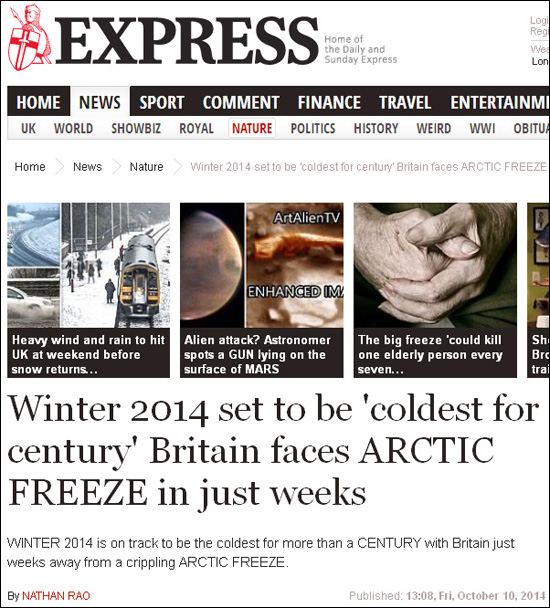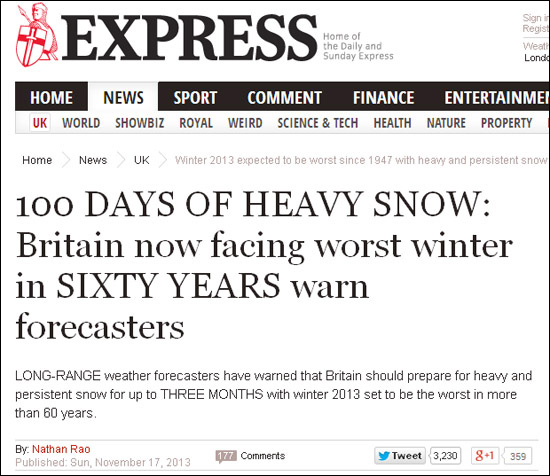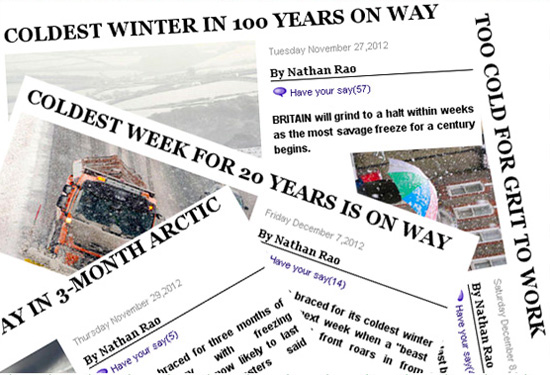

Above: Express, October 10th 2014
“Winter 2014 set to be 'coldest for century' Britain faces ARCTIC FREEZE in just weeks”.
That was the Daily Express headline on October 10th 2014. Quoting self-styled "independent" long-range weather forecaster James Madden, it warned of an icy apocalypse on the way:
“A number of potentially very cold periods of weather and major snow events are likely to develop throughout this winter across large parts of the country, in particular, throughout the latter part of December and into January. The worst case and more plausible scenario could bring something on a similar par to the winter of 2009/10, the coldest in 31 years, or an event close to 2010/11 which experienced the coldest December in 100 years.”
Snow-enthusiasts will recall both January and December 2010 with fondness. The whole of the UK was affected: in Mid-Wales where I live snow covered local beaches above the high water mark and there were copious large ice-floes bobbing about on the Dyfi Estuary. For a while in the days following December 18th 2010, even low-lying towns like Machynlleth were blanketed in thick snow up to a foot deep. 2009-10 was the 59th coldest winter (meteorological period December/January/February) on the Central England Temperature (CET) record which goes back to 1659. 2010-11 was 112th, losing out due to milder conditions arriving in the New Year, although December 2010 at a shocking -0.7C was the second coldest December in the monthly CET record.
That sets the scene. As readers might have guessed, this post is about the UK tabloid press and its ridiculously sensationalistic weather-stories. Firstly, here is the timeline, and brief descriptions of the very severe past winters referred to in the forecasts.
Not to be outdone, the Daily Mirror had the following message for its readers on October 29th:
“Weather experts claiming to have studied air flows in the upper atmosphere say a jet stream that usually holds extreme weather over the North Pole is weak this year. And that could mean the gates are open to a freezing influx of air that could engulf the UK - similar to what happened in 1947 when average temperatures plummeted to -2.7C.”
In all fairness on this occasion, the piece ended with a lonely short sentence:
“Met Office experts have warned that forecasts are less accurate the further in the future they look.”
The winter of 1946-47 is thought to have been the snowiest of the 20th century. Snow fell across the country from late January onwards. The white stuff covered much of the UK for 52 consecutive days: a record amount of non-drifting snow was set with 150 cm lying in parts of North Wales. 1946-47 was the second coldest winter of the twentieth century with a CET of 1.1C, ranking 13th coldest on that temperature dataset. Reportedly, remnants of snowdrifts lasted in the Cotswolds into July.
On November 12th, the Express appeared to be warming to the theme:
“A FREAK series of rare atmospheric events is set to plunge Britain into the worst winter of modern times with heavy snow paralysing the entire country within WEEKS. Shocked forecasters warned tonight the latest high-tech weather models point to a CATASTROPHIC big freeze in late 2014 with THREE MONTHS of blizzards and Arctic gales.“
James Madden was quoted as saying:
“January and into February are likely to offer some potentially severe cold spells of weather and significant snow for many parts of the country, and this is when winter will begin to take even more of a stronghold this year.”
In what seemed to be a growing game of “spot the ice-age”, the Express came back on November 27th with:
“Weather forecasters have today all but unanimously agreed Britain is days away from what could turn out to be the one of the most severe winters in years.”
The piece continued with:
“The terrifying alert echoes earlier warnings from Exacta Weather’s James Madden and Piers Corbyn of Weather Action who for weeks, with the Express, have warned Britain to prepare for the worst.”
The Mirror had to do something to compete for attention, so on December 12th it ran with the following:
“UK weather: Country set for worst winter in 200 years with FIVE FEET of snow”.
It went on to proclaim:
“Britain could soon be shivering in a repeat of the 1963 Big Freeze - the worst winter for more than 200 years. One weather expert has warned Britain will be hit by an Arctic blast which is set to arrive over New Year and hang around for at least a month. Some areas could be blanketed by up to five feet of snow with daytime temperatures hovering around zero and overnight lows down to a bone-numbing -15C (5F). Forecaster James Madden believes the white-out will rival the famous winter of 1963 when the sea froze in Kent and a car was driven across the River Thames in Oxford.”
Madden was quoted as saying:
“During the winter period of 1962/63 the famous big freeze took a hold of the country from around Christmas until the spring of the following year because of a similar situation. Several feet of snow fell in parts of southern England, temperatures dropped to below -20C (-4F) in places, and snow remained on the ground for months on end. We could be looking at a very similar time-frame and scale of events this time around. I don’t like saying this but the factors are there for an extremely cold spell in January which will possibly extend into February.”
The winter of 1962-63 (my first, not that I remember a thing about it) was the coldest of the 20th Century with a CET of a shiveringly -0.33C, the third coldest on record (the second was 1740 at – 0.4C and the all time coldest was 1684 at -1.17C). It was the only winter of the 20th Century with temperatures averaging below zero for two consecutive months: snow covered much of the UK from Boxing Day through to early March.
Above: Digging out. The author is familiar with blizzards, living among the Welsh hills, but major falls at valley-level are relatively uncommon. This was taken in Machynlleth, a few days after the major snow event of December 17th-18th 2010, which combined with overnight temperatures plummeting to -15C added to a month during which the weather could truly be described as extreme.
By the second half of January, there were few signs of any of the apocalyptic predictions having come to pass. There were a few days when snow was observed to be falling, in many cases these involving passing wintry showers. There were a few more widespread snow events. On the lead-in to one such event, on January 24th, James Madden stated on his Facebook page:
“The final part of January and February period is now shaping up to something that could be on a similar par to December 2010 at the very least. There is likely to be frequent and heavy bouts of snow across the whole country, severe blizzards, and major ice problems within this period.”
The Express followed up on January 26th with the headline:
“Britain on RED alert: 'Displaced polar vortex' to unleash crippling snowstorms next week”.
It went on to state:
“Forecasters say temperatures will plunge to below -15C (5F) while feet-deep snow drifts on a par with the worst winters in history are likely. The whole of the UK will be scourged by screaming Arctic gales and blizzards right through the first half of February”.
This time it was the turn of Piers Corbyn:
“This could lead to anything, gales, huge snowstorms and the lowest temperatures of winter so far. We are now 95 per cent certain that the whole of the country will be affected from the start of February. Such is the severity of this situation I have written to the Government’s Cabinet Office Briefing Room (COBRA) committee urging them to take immediate action.”
His comments were echoed by James Madden further down the page. The snowfall on the 29th-30th January, for which Met Office warnings had been issued, was the heaviest widespread one of the winter. Heavy falls occurred in Scotland, northern England and Northern Ireland: road, school and airport closures affected these areas. Tulloch bridge in Inverness-shire had 23cm (9in) of snow while there was 21cm at Glenanne in Armagh, and Spadeadam in Cumbria had 13cm. However, a question has to be asked at this point. How unusual is such a snowfall during the winter months, and how does it compare to 2010-11, 1962-63 or 1947? It doesn't: there's no contest at all.
So, do the numbers reveal how 2014-15 panned out? Indeed they do. Out of the 357 winters in the CET, it ranked 253rd with a CET of 4.54C. Each month had an above average CET: December came in at 5.2C (262nd), January at 4.4 C (255th) and February at 4.0C (181st). Checking through Roger Brugge's excellent weather-diary pages and cross-referencing to the BBC News and Guardian websites, I note that disruptive snowfalls – the sort that widely lead to road and school closures, thereby making the news, occurred on December7th, 10th, and 12th (mostly high level routes in Scotland), the 27th (more widely), January14th (widely), 29th and 30th (widely – see above) and on February 25th (mostly in Scotland). High ground carried snow for much of the season bringing good winter conditions for hillgoers, especially in Scotland. Compared to 2010-11, December 2010, 1962-63 and 1947 this was a rather ordinary winter: a mixed bag of cold days, mild days, wet days, snowy days, sunny days.
Let's just revisit that James Madden forecast that the Express cited on November 12th:
“January and into February are likely to offer some potentially severe cold spells of weather and significant snow for many parts of the country, and this is when winter will begin to take even more of a stronghold this year.”
I put it to Mr Madden that January and February are months when cold outbreaks with widespread falls of snow happen every few years, so that if you say it every year no matter how far in advance then you will eventually be right. I also put it to the readers that the snow and cold temperatures at the end of January 2015 were not particularly severe, significant or prolonged in nature away from the hills, where severe conditions occur in most winters as every year-round hillgoer knows. Likening the end January 2015 snowfalls to the events of 1963 or 1947 is like trying to liken a small firework to a nuclear explosion.

Above: Express, November 17th 2013
In March 2014, I reported at Skeptical Science on the exceptionally mild (345th on the scale with a CET of 6.07), stormy and wet winter of 2013-14. In the run-up to that season we saw an identical phenomenon in the tabloid press: in October 2013, the Express had a front page headline, "Record Snow forecast for November". On November 17th 2013, following a series of pleasantly autumnal days, it followed with, "100 DAYS OF HEAVY SNOW: Britain now facing worst winter in SIXTY YEARS warn forecasters". We all know what happened.
In contrast, the relatively sober contingency outlook for winter 2013-14 from the Met Office was as follows:
“Confidence in the forecast for precipitation across the UK over the next three months is relatively low. For the December-January-February period as a whole there is a slight signal for below-average precipitation. The probability that UK precipitation for December-January-February will fall into the driest of our five categories is around 25 per cent and the probability that it will fall into the wettest category is around 15 per cent.”
Relatively low confidence. A slight signal. They weren't exactly shouting icy doom through a megaphone, then, were they? A low probability of it being very wet or very dry: a betting man might have gone for one (odds = 6.66666-1) or the other (odds = 3-1), and cashed in or lost his shirt appropriately. That is the nature of such uncertainty spelled out in plain English. It is the absolute opposite of the tabloid headlines.
Introducing tabloid weather stories with a strapline that includes the words, "forecasters warn", is a clever way of leaving something wide-open to interpretation. Why? Because they base the meat of such stories on the ramblings of various self-appointed private weather-forecasters (as opposed to mainstream professional meteorologists). They then throw in a carefully-juxtaposed quote or two from the Met Office (often right at the bottom of the piece, where they are less likely to be read properly if at all). This leaves the layperson wondering who said what, and many times since I have heard the Met Office blamed for these "forecasts" when in fact it had nothing to do with them. In recent years, they have found it necessary to issue several rebuttals in such circumstances.
I put it to the readers that tabloid weather-shock stories are little more than clickbait with sly attempts to discredit the Met Office (because of their climate science connections) thrown in. I hold no particular brief against the self-appointed “independent” long-range forecasters, even those who make the preposterous claim to know more than the entire Met Office put together. It is clear to me from previous years spent moderating internet weather forums that some people show a very marked preference for certain types of weather. They selectively interpret the daily forecast model runs and can become most agitated when what they hope will happen, for example heavy snow, doesn't work out for them over their back garden. It happens time and again every winter. There's even a term for it: snow-ramping.
No, what I object to is leading sections of the “news” media repeatedly seizing upon such wild forecasts, sexing them up even more and thereby creating a gigantic straw man for the public to tear down later, inadvertently casting the net of blame more widely in the process. I put it to the readers that any newspaper that repeatedly does such things is not worthy of having the word "news" in any way associated with it. It is no better than giving a platform to climate change contrarians (and some of the tabloids are particularly active on that front). Editors: if you must dedicate a part of the paper to telling people what is going to happen to them without a shred of evidence that it will, then for heavens' sake keep it to the daily horoscope section.
In late 2013 I even wrote a column in my local Welsh newspaper to reassure elderly and other vulnerable people, terrified of a very expensive forthcoming heating bill, after some of them had worriedly approached me on the street. They had read something in the papers: a little querying and I soon knew which papers. Editors: have you the slightest idea of the very real consequences of pushing these evidence-free ice-apocalypse stories? I put it to you that you do, but you do not care. So prove me wrong.
From pretending that climate change (something which, in stark contrast, is supported by a mountain of hard evidence) is some kind of hoax, to sexing up apocalyptic snowmageddon forecasts: the tabloids seem to be all-out to create evidence-free alternative reality as a matter of policy. They could do a lot better. They should do a lot better. But they don't. So the campaign against such daily spoon-fed misinformation, wherever it pops up, will go on and on, rest assured. But in the meantime, I can make one long-range forecast. The nonsense will start all over again next autumn.

Above: Express headlines from late 2012.
Weather-apocalypse headlines in order of appearance:
Express, November 12th 2014
Express, November 27th 2014
Mirror, December 12th 2014
Express, January 26th 2015
Report on late January snowfall
Roger Brugge weather diaries for 2014 and 2015:
http://www.met.reading.ac.uk/~brugge/diary2014.html
http://www.met.reading.ac.uk/~brugge/diary2015.html
CET data, ranked by season and month respectively:
http://www.metoffice.gov.uk/hadobs/hadcet/ssn_HadCET_mean_sort.txt
http://www.metoffice.gov.uk/hadobs/hadcet/mly_cet_mean_sort.txt
Posted by John Mason on Thursday, 26 March, 2015
 |
The Skeptical Science website by Skeptical Science is licensed under a Creative Commons Attribution 3.0 Unported License. |